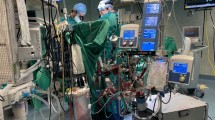Summary
BACKGROUND: In recent years, minimally invasive techniques have entered many areas of surgery. Cardiac surgery, for example, has relied on two different approaches to reduce operative trauma, one by minimizing the incision, the other by avoiding extracorporeal circulation, considered to be responsible for systemic inflammatory response syndrome as well as for neurocognitive disorders. METHODS: In 1999/2000, our department performed 579 CABG operations, 283 without the use of CPB (13 MIDCAB, 270 OPCAB). The demographic data of the two groups of patients are comparable. The OPCAB-patients received 1 to 5 distal anastomoses, 2.7 on average. 62 % of our patients in the off-pump group received at least one anastomosis for a marginal branch of the circumflex artery. We employed two different commercially available mechanical stabilization devices to stabilize the epicardium of the anastomotic region (CTS, Octopus II). RESULTS: Perioperative mortality in our OPCAB group was 1.4 % versus a mortality rate of 3.7 % in the on-pump group. There was a trend toward a decreased perioperative infarction rate in the OPCAB patients group (2.8 % versus 4.8 %). Postoperative drop of platelets and CKMB-levels were significantly lower in the OPCAB-group. CONCLUSIONS: CABG without CPB is a safe alternative to the conventional technique with cardiopulmonary bypass, which has been the “golden standard” during the last decades. In perfect cooperation with the anaesthesiologist, even more difficult revascularization procedures concerning anastomoses to the marginal branches are feasible. Perioperative trauma can be reduced avoiding cardiopulmonary bypass, thereby benefiting especially elderly, multimorbid high-risk patients.
Zusammenfassung
GRUNDLAGEN: In den letzten Jahren konnten sich in vielen Bereichen der Chirurgie minimal invasive Techniken durchsetzen, teilweise konventionelle Operationstechniken völlig ersetzen. Im Bereich der Herzchirurgie wurden zwei unterschiedliche Wege beschritten, einerseits in der Verkleinerung des operativen Zugangs bis hin zu endoskopischen Techniken, andererseits in der Vermeidung der Herz-Lungen-Maschine, welche für das Auftreten systemischer inflammatorischer Reaktionen, aber auch für neurologische Komplikationen verantwortlich gemacht wird. METHODIK: In den Jahren 1999/2000 wurden an unserer Abteilung 579 Patienten einer aortocoronaren Bypassoperation unterzogen, 283 Patienten (49 %) ohne Herz-Lungen-Maschine (13 MIDCAB, 270 OPCAB-Operationen). Die demographischen Daten beider Gruppen sind vergleichbar. Die 270 OPCAB-Patienten erhielten 1–5 distale Anastomosen, im Durchschnitt 2,7; 62 % unserer Patienten erhielten zumindest eine Anastomose an einen marginalen Ast der Arteria circumflexa. Zwecks sicherer Durchführung der peripheren Anastomosen wurden zwei verschiedene handelsübliche mechanische Stabilisatoren (CTS, Octopus II) verwendet. ERGEBNISSE: Die perioperative Mortalität war in der OPCAB-Gruppe tendenziell geringer als in der On-Pump-Gruppe (1,4 % versus 3,7 %). Die postoperative Enzymerhöhung sowie die Reduktion der Thrombozytenzahl war in der OPCAB-Gruppe signifikant geringer. SCHLUSSFOLGERUNGEN: Aortokoronare Bypassoperationen ohne Herz-Lungen-Maschine stellen eine sichere Alternative zur konventionellen Operationstechnik mit extrakorporaler Zirkulation dar. Durch eine perfekte Zusammenarbeit mit dem Anästhesisten können selbst schwierige Revaskularisationen der lateralen und posterioren Wandabschnitte ohne HLM durchgeführt werden und somit das operative Trauma reduziert werden. Dadurch profitieren besonders multimorbide Patienten mit hohem operativen Risiko.
Similar content being viewed by others
Author information
Authors and Affiliations
Corresponding author
Rights and permissions
About this article
Cite this article
Thalmann, M., Trampitsch, E., Sorre, C. et al. OPCAB: Reducing the Perioperative Risk Avoiding Extracorporeal Circulation in CABG Surgery. Eur Surg 35, 327–329 (2003). https://doi.org/10.1007/s10353-003-0040-9
Issue Date:
DOI: https://doi.org/10.1007/s10353-003-0040-9
Keywords
- Off-pump coronary artery bypass grafting
- Minimally invasive technique
- Cardiopulmonary bypass
- Extracorporeal circulation




